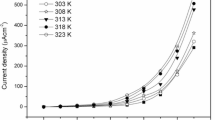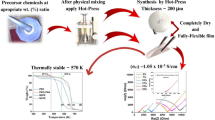Abstract
Sodium-ion-conducting poly(ethylene oxide) (PEO)-based solid polymer electrolyte films mixed with salt sodium thiocyanate (NaSCN) have been prepared by solution-cast method. Films were characterized in detail using optical microscopy, differential scanning calorimetry, and impedance spectroscopy. The drop in ionic conductivity with increasing salt concentration is supported by a decrease in number of charge carriers. Dielectric constant is supported by decreases in numbers of charge carriers and increase in mobility. The maximum ionic conductivity and number of charge carriers for material are found 9.86 × 10−6 S/m and 1.21 × 1020, respectively, for weight % ratio (95:05) of PEO:NaSCN polymer salt complex. The maximum mobility of material is found 2.58 × 10−6 m2/Vs for weight % ratio (80:20) of PEO:NaSCN polymer salt complex.




Similar content being viewed by others
References
MacCallum JR, Vincent CA (eds) Polymer electrolyte reviews,volume-1, Springer Netherlands (1987), pp 351 and Polymer Electrolyte Reviews, volume -2. Elsevier Science Publishers Ltd., New York (1989), p 338
Fenton DE, Parker JM, Wright PV (1973) Complexes of alkali metal ions with poly (ethylene oxide). Polymer 14:589
Wright PV (1975) Electrical conductivity in ionic complexes of poly(ethylene oxide). Polym Int J 7:319
Chandra S (1981) Superionic solids: principles and applications. North Holland, Amsterdam
Nogueira AF, Durrant JR, De Paoli MA (2001) Dye-sensitized nanocrystalline solar cells employing a polymer electrolyte. Adv Mater 13:826
Singh PK, Nagarale RK, Pandey SP, Rhee HW, Bhattacharya B (2011) Present status of solid state photoelectrochemical solar cells and dye sensitized solar cells using PEO-based polymerelectrolytes (review article). Adv Nat Sci Nanosci Nanotechnol 2:023002
Armand MB, Chabogno JM, Duclot MJ (1979) In: Vashista P, Mundy JN, Shenoy GK (eds) Fast ion transport in solids. North-Holland, Amsterdam, p 131
Plocharski J, Wieczorek W, Przyluski J, Such K (1989) Mixed solid electrolytes based on poly (ethylene oxide). Appl Phys A 49:55
Bailey FE, Koleske JV (1976) Poly (ethylene oxide). Academic Press, New York
Gray FM (1997) Polymer electrolytes. Royal society of chemistry, Cambridge
Cameron GG, Ingram MD (1989) In: MacCallum JR, Vincent CA (eds) Polymer electrolyte reviews, vol 2. Elsevier, London, p 157
Hashmi SA, Chandra S (1995) Experimental investigations on a sodium-ion-conducting polymer electrolyte based on poly (ethylene oxide) complexed with napf6. Mater Sci Eng B 34:18–26
Wintersgill MC, Fontanella JJ, Greenbaum SG, Adamic KJ (1988) D.s.c, electrical conductivity, and n.m.r studies of salt precipitation effects in PPO complexes. Polym Int 20:195
Greenbaum SG, Pak YS, Wintersgill MC, Fontanella JJ, Schultz JJ (1988) NMR, DSC, DMA, and high pressure electrical conductivity studies in PPO complexed with sodium perchlorate. J Electrochem Soc 135:235
Fauteux D, Lupien MD, Robitaille CD (1987) Phase diagram, conductivity, and transference number of PEO-NaI electrolytes. J Electrochem Soc 134:2761
Kumar SR, Aparna Y (2016) Synthesis and characterization of PEO complexed with NaClO4 soluble base salt and Nb2O5 Nano-filler. IJOER 2:16
Bhattacharya B, Nagarale RK, Singh PK (2010) Effect of sodium- mixed anion doping in PEO- based polymer electrolytes. High Perform Polym 22:498–512
Vittadello M, Waxman DI, Sideris PJ, Gan Z, Vezzù K, Negro E, Safari Greenbaum AS, Noto VD (2011) Iodide-conducting polymer electrolytes based on poly-ethylene glycol and MgI2: synthesis and structural characterization. Electrochim Acta 57:112–122
Aziz SB, Abidin ZHZ (2015) Ion-transport study in nanocomposite solid polymer electrolytes based on chitosan: electrical and dielectric analysis. J Appl Polym Sci 132:41774
Schutt HJ, Gerdes E (1992) Space-charge relaxation in ionicly conducting glasses. II. Free carrier concentration and mobility. J Non-Cryst Solids 144:14–20
Chaurasia SK, Saroj AL, Shalu SVK, Tripathi AK, Gupta AK, Verma YL, Singh RK (2015) Studies on structural, thermal and AC conductivity scaling of PEO-LiPF6 polymer electrolyte with added ionic liquid [BMIMPF6]. AIP Adv 5:077178
Buraidah MH, Teo LP, Majid SR, Arof AK (2009) Ionic conductivity by correlated barrier hoping in NH4I doped chitosan solid electrolytes. Phys B Condens Matter 404:1373–1379
Author information
Authors and Affiliations
Corresponding author
Rights and permissions
About this article
Cite this article
Gupta, S., Singh, P.K. & Bhattacharya, B. Charge carriers dynamics in PEO + NaSCN polymer electrolytes. Ionics 24, 163–167 (2018). https://doi.org/10.1007/s11581-017-2181-z
Received:
Accepted:
Published:
Issue Date:
DOI: https://doi.org/10.1007/s11581-017-2181-z




